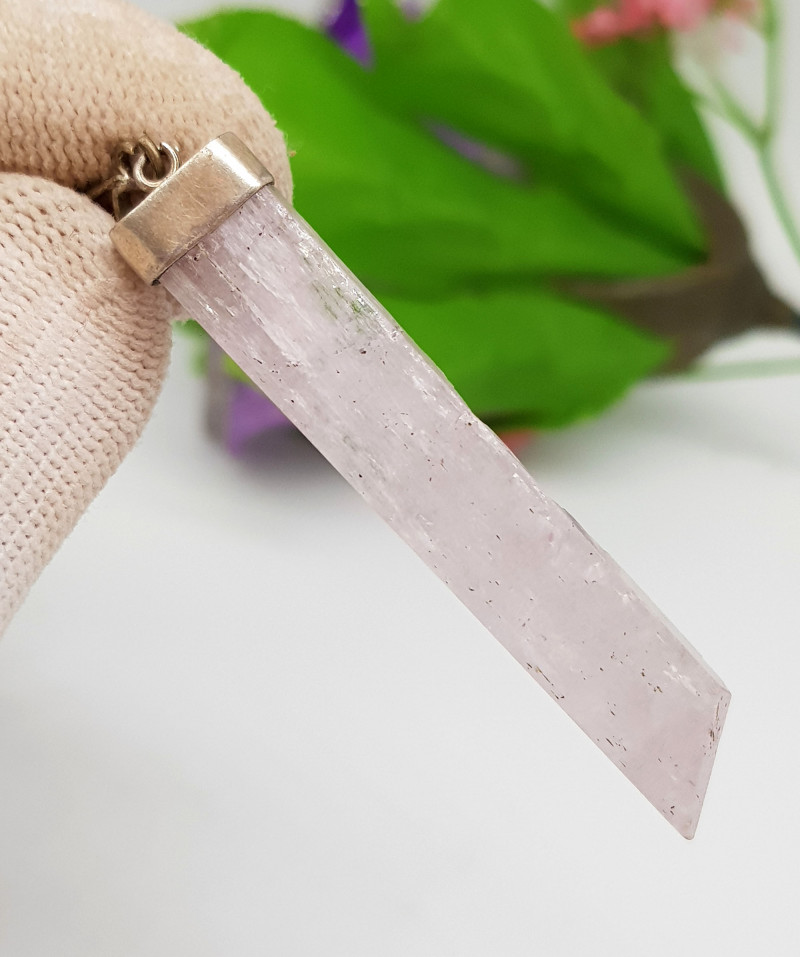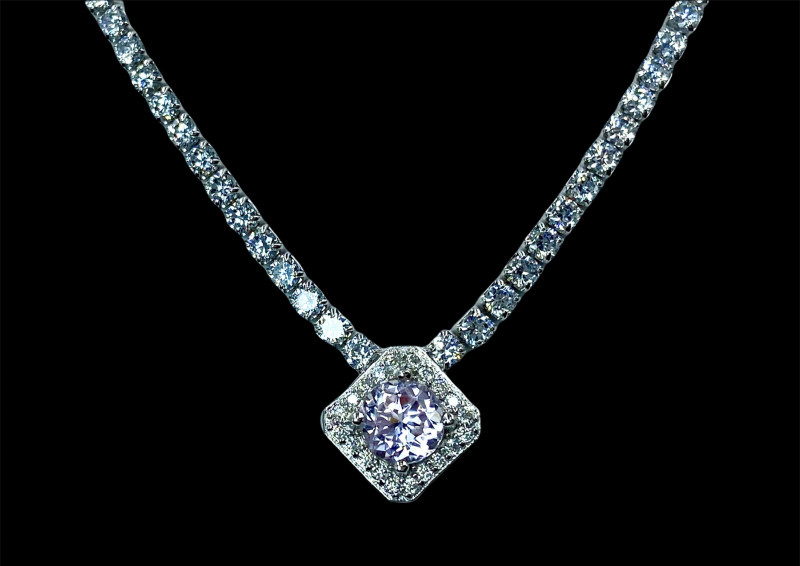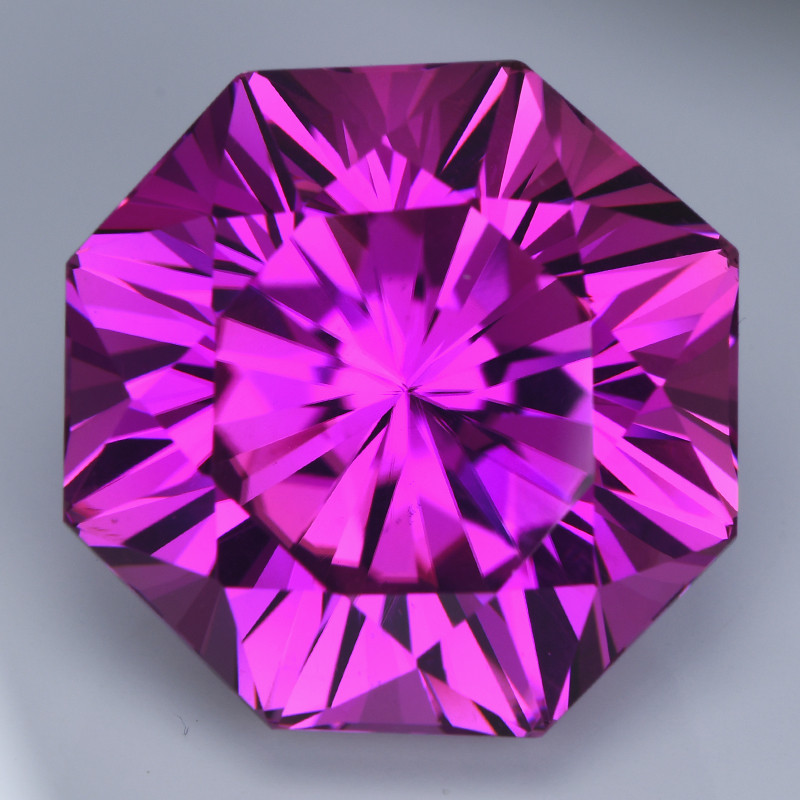
Kunzita: una guía completa sobre sus propiedades, usos curativos y valor
 La kunzita es una piedra preciosa de color rosa a violeta descubierta recién en 1902. Esta gema es el miembro más conocido de la familia de minerales espodumena a pesar de ser la más joven.
La kunzita es una piedra preciosa de color rosa a violeta descubierta recién en 1902. Esta gema es el miembro más conocido de la familia de minerales espodumena a pesar de ser la más joven.
Esta gema se destaca por su excelente claridad, colores encantadores y un fuerte pleocroísmo (que muestra diferentes colores desde distintos ángulos de visión).
Aparte de los gemólogos, la mayoría de la gente no conocía la kunzita hasta una subasta de Sotheby's en 1996. Ese año, uno de los artículos disponibles era un gran anillo con piedra preciosa de kunzita (acentuado con diamantes) propiedad de la ex primera dama Jackie Kennedy.
Su marido, el presidente John F. Kennedy, lo compró como regalo de Navidad apenas unas semanas antes de ser asesinado en noviembre de 1963. ¡Terminó vendiéndose por 431.250 dólares!
No te preocupes, ¡la kunzita también está llena de cualidades brillantes y alegres! Hoy las repasaremos todas mientras hablamos sobre los significados de la kunzita, sus propiedades curativas, su precio y más.

¿Qué es la kunzita?
La kunzita es una gema semipreciosa con delicados y románticos tonos que van del rosa al violeta. Es sutil y hermosa, perfecta para cualquier atuendo, pero se la conoce como la "piedra del atardecer" porque, por desgracia, suele desteñirse con la luz solar directa.
Llamada inicialmente "espodumena lila", algunos nombres comerciales antiguos para la kunzita incluyen salmonita, sicklerita e "iris de California". Todos se relacionan con su controvertida historia, que abordaremos en breve.
¿Tienes bebés en San Valentín? ¡Te alegrará saber que la kunzita es una piedra de nacimiento alternativa para febrero ! También es una piedra del zodiaco para Tauro, Leo y Escorpio.
Si pronto celebrarás tu 32º aniversario de bodas pero tienes un presupuesto limitado, ¡la kunzita es una alternativa más asequible a la morganita tradicional!

Especificaciones y características de la kunzita
El mineral kunzita es un silicato de litio y aluminio, junto con la hiddenita, una piedra similar a la espodumena. Sus suaves tonos provienen de pequeñas cantidades de manganeso que se filtran durante su formación.
¿Es la kunzita rara? Algo rara. La kunzita solo es realmente rara en colores saturados y, aun así, no es tan rara como la hiddenita.
Aquí están las propiedades restantes de la kunzita:
Dureza de Mohs : 6,5-7
Color : rosa, violeta o lila
Estructura cristalina : monoclínica
Brillo : Vítreo (similar al vidrio)
Transparencia : Transparente a translúcido
Índice de refracción : 1,66-1,68
Densidad : 3,1-3,2
Escote : Perfecto, 2 direcciones
Fractura : Desigual a subconcoidea
Raya : Blanca
Luminiscencia : Fosforescencia (brillo duradero) en color naranja-rosa; A veces termoluminiscencia (brillo inducido por el calor) en color naranja.
Pleocroísmo : Fuerte en incoloro, violeta y rosa.
Pasando de lo mineral a lo metafísico, ¿qué simboliza la piedra kunzita?

Significado e historia de la kunzita
Aunque es bastante moderna, la kunzita ha adquirido una gran cantidad de significados en el último siglo. Sus tonos rosados reflejan sanación, amor incondicional y bondad.
Se han atribuido muchas cualidades femeninas a la kunzita, desde leyendas que afirman que las mujeres que la usan encontrarán su verdadero amor hasta creencias de que representa la fertilidad.
El nombre "kunzita" rinde homenaje a George Kunz, reconocido gemólogo de Tiffany. A pesar de la creencia popular, Kunz no descubrió la gema. Sin embargo, al menos cuatro mineros diferentes podrían atribuirse ese mérito.
Historia: ¿Quién descubrió la kunzita primero?
El primer descubrimiento de kunzita ocurrió definitivamente alrededor de 1902 cerca de Pala, California, EE. UU. El primer supuesto descubridor del que hablaremos es Frederick M. Sickler .
Sickler encontró los especímenes en la mina White Queen y luego se los pasó a George Kunz en 1902. Kunz se dio cuenta de que potencialmente eran una nueva variedad de espodumena.
Kunz envió muestras a Charles Baskerville, profesor de química de la Universidad de Carolina del Norte, quien finalmente eligió el nombre. Juntos publicaron la primera descripción completa de la gema en 1904.
Otros descubridores
A fines de 1902, HC Gordon, uno de los corresponsales de Kunz en la mina, le escribió a Kunz para aclarar que los mineros Pedro Peiletch y Beranardo Heriart lo encontraron con Sickler en la mina White Queen.
Para mayor confusión, un periódico local publicó que Frank A. Salmons fue el primero en descubrir la gema en la mina Pala Chief. En 1904, Sickler escribió a Kunz sobre esto, añadiendo que los operadores de la mina Pala Chief (entre ellos Salmons) afirmaron erróneamente que su yacimiento era el único de kunzita.
En ese momento, Kunz confió en los operadores de la mina Pala Chief para obtener la mejor kunzita en bruto. Para dividir la diferencia, Kunz declaró en su informe que Sickler "parece" el descubridor legítimo.
Nombres comerciales
Más de una década después, en 1915, Kunz todavía tenía algunas disputas.
El secretario jefe de minas de Pala, R. Fenton, presionó para que se utilizara el nombre comercial “California iris”, que había ganado terreno en los mercados europeos, pero Kunz creía que “kunzite” era el título apropiado (no un nombre comercial separado).
Sin embargo, el nombre "lirio de California" pronto desapareció. Salmons le escribió a Kunz en 1919, ofreciéndole más muestras de "kunzita"; era evidente que incluso Salmons se había dado por vencido.
Afortunadamente, Sickler y Salmons tenían minerales completamente separados (sicklerita y salmonsita) que recibieron su nombre en 1912.

Propiedades curativas de la kunzita
Todas las gemas pueden ser piedras curativas que ayudan a tratar diversas dolencias. ¿Para qué sirve la kunzita?
Como gema rosa , las propiedades curativas de la kunzita rosa se conectan con la fertilidad, el romance y el amor. ¡No es de extrañar que sea una poderosa piedra para el chakra del corazón! La kunzita púrpura, al igual que otras gemas púrpuras , puede aportar creatividad, pasión y sabiduría espiritual.
¡Siga leyendo para conocer los beneficios físicos y emocionales de la piedra kunzita!
Curación física
Los usos generales de la kunzita incluyen favorecer el sistema cardiovascular y la reproducción celular. La naturaleza femenina del cristal de kunzita puede aportar beneficios a las mujeres, como el tratamiento del desequilibrio hormonal, los dolores del embarazo y la depresión posparto.
Sanación emocional
La kunzita puede hacer maravillas para la curación emocional, disipando la soledad y abriendo tu corazón para amarte incondicionalmente a ti mismo, a los demás e incluso a la naturaleza.
La piedra puede armonizar la mente y las emociones. Se dice que fomenta la autoexpresión e infunde alegría de vivir , o disfrute entusiasta de la vida.
Sin duda, es un valioso cristal curativo, pero ¿es la kunzita una gema valiosa? Todo depende de su calidad.

Propiedades de la piedra preciosa kunzita
La gama de joyas de kunzita disponibles es lo suficientemente diversa como para satisfacer las necesidades de cualquier comprador. Para ser un comprador experto en kunzita, es importante saber qué buscar.
Los expertos determinan el valor de la kunzita de forma similar a la de la mayoría de las gemas, basándose en su color, claridad, corte, peso en quilates y tratamientos.
Color
El factor de valor más influyente son los colores de la kunzita. La mayoría de las piedras de kunzita son pálidas, generalmente de color rosa claro. Algunas son tan pálidas que parecen incoloras, con un ligero matiz rosado. Otros tonos rosados incluyen el rosa melocotón y el rosa lila.
¿Cuál es el mejor color de la kunzita? Los tonos rosados intensos y los más raros, como el púrpura o el magenta brillante, son los más valiosos. Las kunzitas bicolores también son muy apreciadas.
Claridad
La kunzita rara vez presenta inclusiones visibles, lo que le otorga una claridad de gema coloreada de Tipo I. Esto significa que la mayoría de las gemas tienen buena claridad, por lo que no afecta demasiado su valor.
Según GemVal, casi el 65 por ciento de las kunzitas que han evaluado pertenecen a VVS (Very Very Slightly Included), la categoría de claridad más alta.
Es comprensible que cualquier gema con inclusiones visibles tenga un valor menor, pero no debería tener problemas para encontrar kunzitas sin inclusiones.

Cortar
La perfecta división de la kunzita en dos direcciones y su color más intenso en el lado más largo (del cristal) hacen que sea un poco difícil de cortar, pero extremadamente gratificante si se hace bien.
La ausencia general de inclusiones abre la kunzita a un mundo de hermosos cortes facetados , incluyendo cortes escalonados como la esmeralda o formas cojín. Sin embargo, se puede encontrar la piedra en prácticamente cualquier corte, incluyendo cabujones y tallas.
Peso en quilates
El peso en quilates no afecta drásticamente el valor de la kunzita, ya que suele encontrarse en tamaños enormes. Las piedras preciosas de entre 10 y 20 quilates son bastante comunes. El precio por quilate solo aumenta ligeramente para las piedras de menos de 5 quilates en comparación con las de más de 10 quilates.
Actualmente, el Smithsonian exhibe la kunzita facetada más grande conocida: ¡una enorme gema de 880 quilates!
Tratos
Algunas gemas de kunzita se someten a tratamientos de irradiación, calentamiento o ambos para realzar o cambiar su color. La irradiación y el calentamiento hacen que la kunzita, incolora, se torne rosa. Los tratamientos térmicos a baja temperatura (100-250 °C) pueden tornarla de un rosa violáceo a un rosa claro.
Además, la kunzita que ha perdido su color por la exposición a la luz solar (decoloración por calor) a veces puede recuperarse mediante irradiación. Sin embargo, debe someterse a calor o luz inmediatamente después para eliminar los matices marrones o verdes.
Los expertos señalan que los tratamientos en ciertos países pueden ser más estables. Muchas kunzitas tratadas en Taiwán o Brasil conservan mejor su color que las tratadas en Pakistán.
Sin embargo, la kunzita tratada suele ser más propensa a perder color bajo la luz del sol que la kunzita sin tratar.

Formación y fuentes de kunzita
La kunzita se forma dentro de pegmatitas ricas en litio. Primero, el magma caliente asciende bajo tierra, acercándose a la superficie terrestre. A medida que el magma se enfría, se forman cavidades, vetas y burbujas de gas.
El agua penetra en estos puntos, recogiendo minerales disueltos como la sílice. Al asentarse, el agua se evapora y los minerales cristalizan. Para que se forme la kunzita, es necesaria la presencia de manganeso, que le otorga a la gema su color característico.
Ubicaciones mineras
Si bien el origen de la kunzita en California sigue siendo una fuente importante, la mayor parte de la kunzita actualmente proviene de Pakistán y Afganistán.
Otras fuentes incluyen:
Brasil
Canadá
Madagascar
Myanmar (Birmania)
Suecia
Estados Unidos (Carolina del Norte y Dakota del Sur)
Cabe destacar que las kunzitas de Afganistán a veces pueden mostrar un pleocroísmo intenso en tonos violeta intenso, verde claro y violeta claro. Además, algunos expertos creen que la kunzita de Pala, California, es menos fotosensible (propensa a decolorarse con la luz solar).
Hablando de su calidad, ¿cuánto vale la kunzita?

Precio y valor de la kunzita
A pesar de su lujosa belleza, la mayoría de las gemas de kunzita cuestan menos de 20 dólares por quilate. ¿Por qué es tan barata? No mucha gente la conoce, así que su popularidad no está impulsando la demanda (ni, por ende, los precios).
De ninguna manera es “barato” en un sentido coloquial: su calidad puede rivalizar con la del zafiro rosa a una fracción del costo.
El color es clave para el precio de la kunzita. A continuación, se muestran los precios generales al por mayor de las gemas de kunzita facetadas por color:
Rosa claro : $5-$10 por quilate
Rosa medio : $15-$30 por quilate
Lila : $10-$30 por quilate
Morado oscuro o magenta : $20-$60 por quilate
Si bien estas gemas suelen ser grandes, las kunzitas de más de 10 quilates (incluso en tonos más claros) pueden costar hasta 180 dólares por quilate.
Los cabujones de kunzita tienen un precio mucho más bajo, entre $0,30 y $3 por quilate al por mayor. Puede esperar pagar incluso menos por la kunzita en bruto , entre $0,03 y $1,50 por quilate.

Cuidado y mantenimiento de la kunzita
La kunzita tiene una dureza razonable, pero su perfecta clivaje bidireccional significa que un golpe fuerte puede partirla por la mitad desde cualquier ángulo. Recomendamos optar por joyas menos vulnerables, como colgantes o aretes de kunzita. También puede proteger su anillo de kunzita con un engaste protector .
El cuidado más importante de la kunzita, especialmente de las piedras tratadas, es evitar la exposición a la luz solar directa o al calor. Evite usar joyas de kunzita en días soleados al aire libre.
La pérdida de color no es instantánea; algunos expertos afirman que muchas kunzitas naturales pierden su color entre un 5 % y un 15 % con el paso de los años. Sin embargo, cada piedra puede ser diferente, así que conviene ser precavido.
Limpiar la kunzita es sencillo. Frótela suavemente con un cepillo de dientes suave humedecido en una solución de agua tibia y jabón suave. Luego, enjuague cualquier residuo y séquelo con un paño de microfibra.
Guarde su gema o joya de kunzita en un lugar oscuro y fresco, separado de otras gemas.
¿Estás interesado en la kunzita?
Ahora que ya conoces la kunzita, es fácil ver por qué esta gema rosa es un tesoro subestimado. Su atractivo rosa cautiva al instante, nutre el amor y te anima a abrazar tu propia creatividad y carisma.
¿Buscas una gema rosa suave pero cautivadora? ¡ Compra kunzita hoy mismo!
Buscar en el Gemstone Encyclopedia
Subastas relacionadas
Artículos relacionados
Cada persona tiene una piedra preciosa que corresponde a su signo zodiacal. Estas también se conocen como tu Piedra Estelar. Aprende más sobre estas piedras y descubre cuál es tu Piedra Estelar.
10th May 2018
Originalmente, las piedras de nacimiento o gemas se asociaban con un signo zodiacal o el mes de nacimiento de una persona. Descubra cuál es su piedra y vea las que tenemos a la venta.
8th Feb 2021
Hay docenas de gemas de cuarzo y calcedonia con diversos colores y patrones. ¡Aprenda todo sobre las propiedades del cuarzo y cada tipo de cuarzo, desde la amatista y el ágata hasta el cuarzo plasma y el cuarzo fantasma!
15th Oct 2020
últimos artículos
Las tallas de marfil de palma, también llamadas marfil vegetal, son una alternativa natural al marfil de elefante, extraído éticamente de la nuez de palma de la palmera sudamericana Phytelephas. ¡Aprenda todo sobre el marfil de palma en esta guía!
15th Jan 2026
Las piedras de flores de crisantemo son maravillas naturales que presentan un patrón floral de calcita blanca, celestita o andalucita sobre piedra caliza negra o lutita.
13th Jan 2026
La piedra solar reticulada arcoíris es una variedad de feldespato con tres magníficos efectos ópticos causados por la presencia de diversas inclusiones. Su vibrante colorido y su patrón reticular la convierten en una rara joya de colección.
12th Jan 2026
Categorías de artículos
How To's is where you will find helpful articles from gem Rock Auctions on how to cut gemstones, select gemstones and buy gemstones.
9 Artículos





